FESTIVAL of ST.
MARGARETHEN in
BURGENLAND (A)
On
several occasions I have written about our visits to Burgenland in
eastern
I found
some data in my “Diversities” and “Epistles” and compiled others from
various
sources referring to the open-air stage at the old Roman Quarry at St.
Margarethen. This open-air arena of some 7.000m² is the largest one in
The
settlement St. Margarethen documentary mentioned in 1232 for the
first time. There
are a few archaeological sites of the younger Stone Age found in the
hilly area
3km west of the Neusiedler See. Also Romans left their traces to be
found along
the “
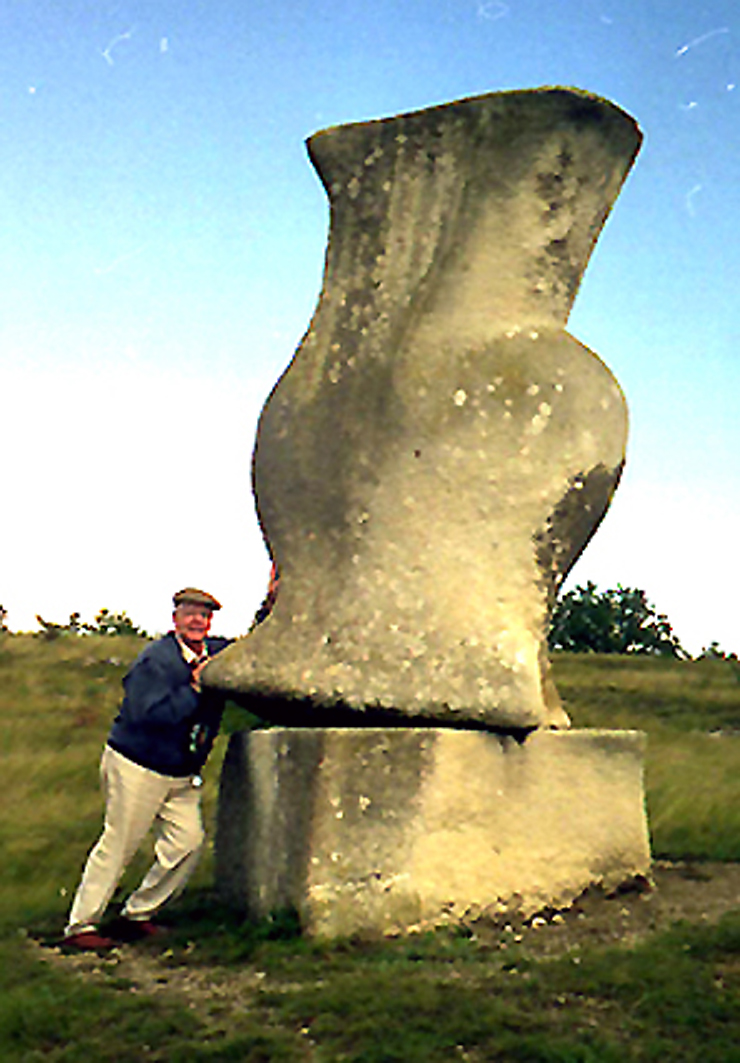
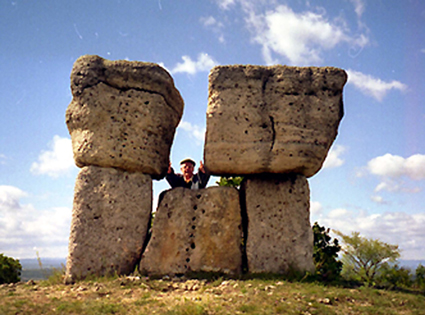
Limestone
sculptures at the Arts’ Park on the
hill above
the mine
The
limestone quarry is still in use these days and its walls are about 40m
high
forming a rather wide amphitheater. On top of the hill knoll at +226m
ASL
stands the “Rosaline” Chapel from where one has splendid around views
on the Neusiedler
See at East, the
The
opera
of Verdi’s NABUCCO at the Festival at St. Margarethen in August 2000
was the
first one we have attended to. A year before we read some magnificent
critics
about the staging of Mozart’s opera MAGIC FLUTE. The only problem
mentioned was
the sitting on proffered hard wooden benches. These have been
rewardingly
replaced with the seat’s rows made of aluminum for the season in 2000.
However
one advised taking cushions and blankets, warm clothing and rain
ponchos when
going to sit at this open-air stage. In that amphitheater the nights
may get
quite cool and sometimes it drizzles too despite that the Festival
starts in second
half of July and lasts until the last decade of August. At that time
summers should
be intense and rather hot around the Neusiedler See region though.
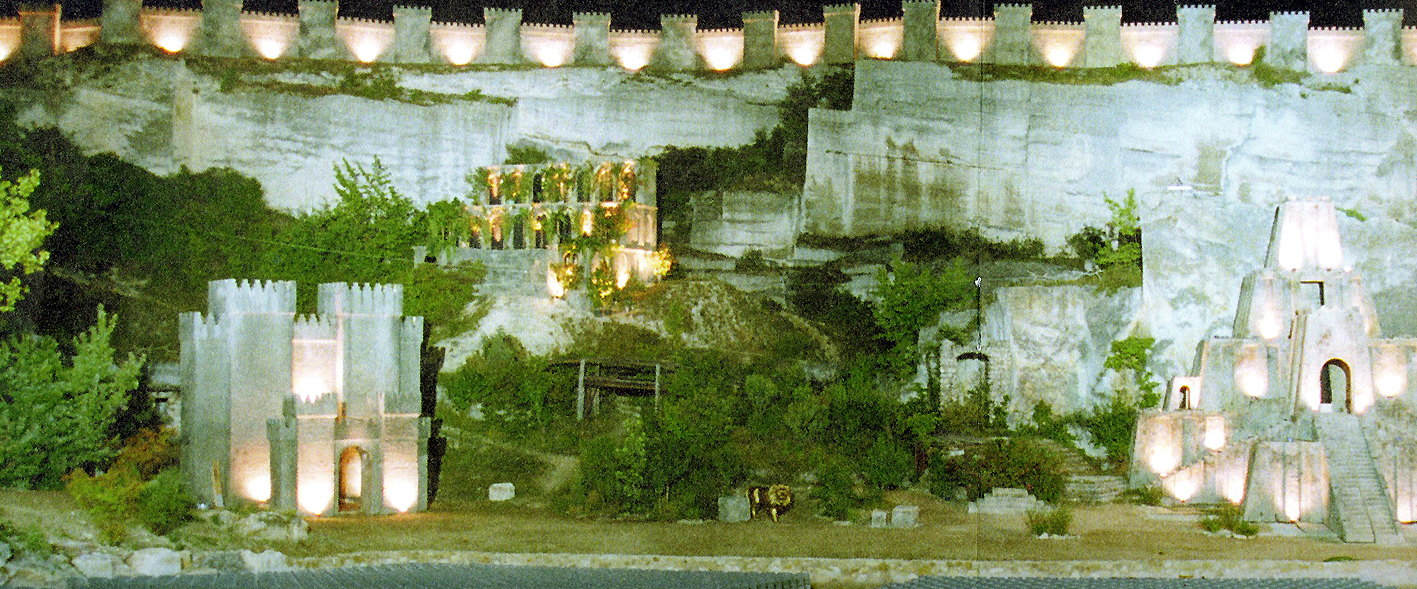
A sepia copy of NABUCCO stage painting in 2000
Night by
night some 4.250 spectators enjoyed spectacular performances and a
perfect acoustic
on this largest open-air stage of
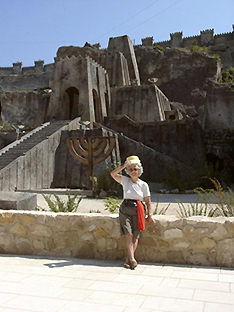
Ljiljana is posing in front of the NABUCCO's stage
The following year Festival’s stage manager Wolfgang Werner was freed of his duties. Every fifth year since 1961 one performs the PASSIONS PLAY on this same open-air stage. The “Passionsspiele St. Margarethen” foundation member of EUROPASSION and the first Passions Play was staged in a farm in 1926. Some 450 laymen actors and some more 200 co-workers participate in the play most of them are local inhabitants. In 2001 there were a total of 20 presentations attended by some 70.000 spectators. The play starts at 17 hours and lasts for about 2 hours.
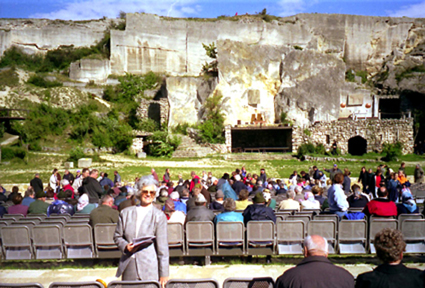
The stage photo prior to the
begin of the play
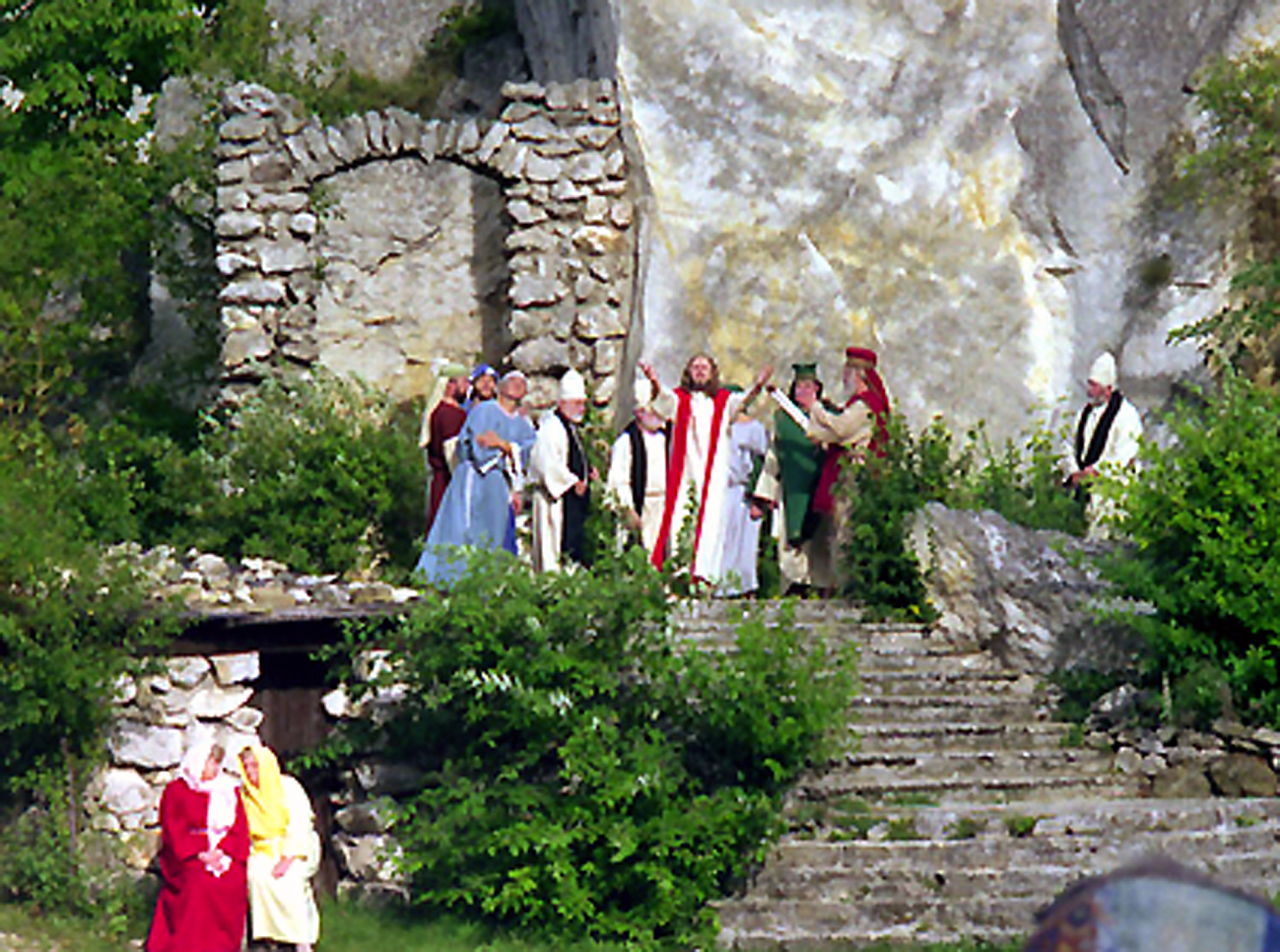
A scene from the Passions' play
Even the
weather acted with so from a slightly cloudy sky at begin gradually
with the
wind thick dark clouds gathered as a sign of an oncoming rainstorm. By
some
miracle one could hear the rumbling of lightning from far during the
crucifixion scene making the scene too realistic to be true after all.
The spectators
were leaving quietly the arena somehow shaken and taken aback when the
play
ended. The dimmed light by thick clouds made the scenery somehow
ghostly
looking stage in that almost natural left quarry ground. Miraculously
sun came
out low art west creating a double (inverted) rainbow on a dark clouded
background. We overhead a commentary that this resulted from the
presence of
two bishops who attended this play on that day.
Local
people told us that it never rained during the season of Passion’s
plays. They
said that the management has a “special” concord with the Almighty and
both
sides adhered to it since long time. However for the year 2002 this
accord
obviously would not held. We had tickets for Verdi’s opera OTHELLO for
Sunday
August 11 on the day the great rains started in western provinces of
On the
way back from a day trip to the northeast of Burgenland we got in a
rain
downpour and we wondered whether one would keep on with the opera later
at
night. Fortunately the rain stooped at
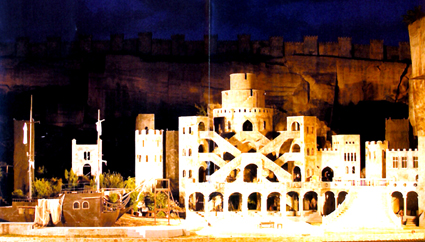
The huge stage showed a mighty
castle and a harbor quay
at left front
Soon the
stage lights were put when the young producer/casting director W.
Werner
introduced the venerable Marcel Prawy to give his usual introduction
speech (to
be his last one as he died soon after). He had to cut it short due to a
light
rain so the orchestra started with the overture to Verdi’s OTELLO
instantly. It’s
the rule that one gets the ticket price back if it rains more than a
half-of-hour. As the music progressed the stage filled with peoples
“looking”
at the sea where Othello lead his fleet in a sea battle against the
Turkish
aggressor. The overture music markedly describes an intense storm
during the
sea battle and is accompanied by some gun shots and artificial
lightning cum
thunder tune. Suddenly the natural thunder rumble joined in making the
whole
performance almost realistic. After the “ship” docked at the quay the
victorious Othello disembarked and the opera proceeded in its normal
theatrical
way. Miraculously the drizzle stropped soon after so everybody could
take of
plastic ponchos little by little.
The
performance went on in the best way and even stars appeared offstage.
Those of
you who know Verdi’s OTHELLO may ask how the stage director has put on
Desdemona’s sleeping chamber on this very wide dais. Well, one pulled
forward almost
to the stage center most of a three-mast “ship” some 25m long. A
chamber with a
large bed and curtains came into view by opening a wide aperture in
ship’s
right flank. This was a rather interesting solution that worked
perfectly
giving the necessary intimacy to the last opera’s act. The beautiful
fireworks
followed afterwards that was somehow out of place with the tragic opera
ending.
The well organized traffic out of parking lots enabled us to be back to
the hotel
within an astonishing time of half hour only.
The
weather improved for the rest of our prolonged stay in Burgenland. We
had
tickets of August 14 for E. Kalman’s operetta “The Czardas Princess” at
Mörbisch
on the open-air platform of
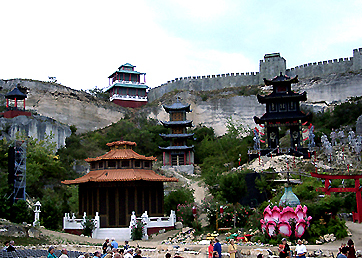
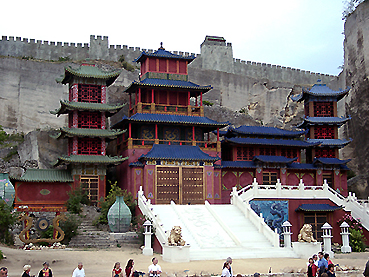
Generally
we drove to Burgenland the shortest way altering the roads as far
possible. We
took more on the return voyage and choose different places for an
overnight
stop. Thus we have been visiting many castles open to the public,
several
cultural interesting sites and some parks and natural reserves too. On
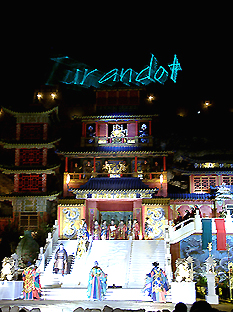
The
scene showing the moment of Prince Kalaph's third answer
The opera performance
turned into a grand spectacle with many
exceptional illumination effects. The singers and co-operating players
were
clad multi colored costumes so one could just grasp a detail here or
fast
change of a scene there. I
have
tried my digital camera for the first time and pictures came out
amazingly
good. Thus encouraged I would make new trials possibly the next time.
We booked
tickets for Verdi’s opera AIDA on
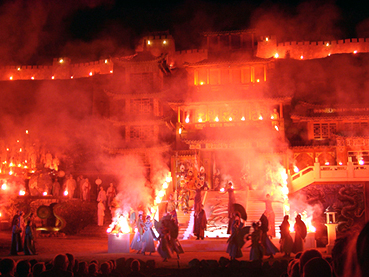
Swift
movements and blaze of lights, Bengal fires and laser splodges all over
the wide stage
On
Friday August 20th we were had tickets for Verdi’s Aida in the evening
and
thought to go shopping to Sopron (H) in the morning. Unfortunately all
shops
were closed due to the national holiday – the Millennium of Hungarian
Kingdom.
Somehow disappointed we shopped in St. Margarethen and reserved tickets
for
Bizet’s CARMEN in 2005.
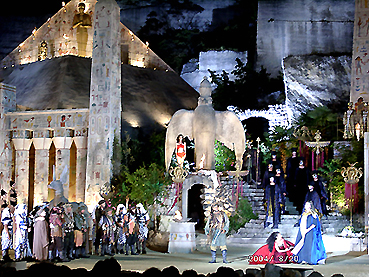
A scene from the first act: in front is
Amneris at right and Aida and Amonasro at left
The
performance of AIDA was spectacular again particularly the first act.
The most
attractive of all was the entrance of Radames as the victorious
Egyptian army
commander leading the rather long procession of war bounty. Horsemen
rod along
the carriages loaded with goods of bounty and two elephants led a long
raw of
prisoners. The elephants came from a circus and one of them tore of
tree a
branch and walked chewing it to the stage. Later the still chewing
leading
elephant slowly resumed his pace on his own at a certain tune from the
orchestra.
We
started our return voyage later as anticipated as we went for shopping
to
Sopron (H) first. This time we choose the way back via north regions of
Our
sixth trip to Burgenland up to date was the shortest one. This year
2005 we had
to change our quarters staying in Klingenbach village just across the
border to
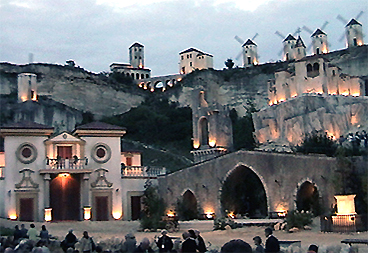
The
left part of stage representing Sevilla for the
opera CARMEN prior to begin
Although
Bizet’s music cannot be compared to say in Verdi’s grand operas but the
stage
setup was noteworthy again. Horsemen had many chances to rush to and
fro and
their procession was spectacular in last act prior of the bull fight in
the
arena (left at picture as almost exact copy of in Sevilla). A friend
commented
that he had never seen so many people stroll the street in Sevilla
during the
lunch time that is the time when the tobacco factory came out for
repose in the
opera.
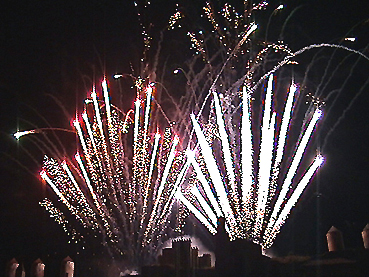
The
opera CARMEN spectacle ended with a magnificent firework and a new
record of
222.785 visitors in 2005. With a firework picture I am to end my report
of our visits
to the Festival at St. Margarethen during the past continuous six years.